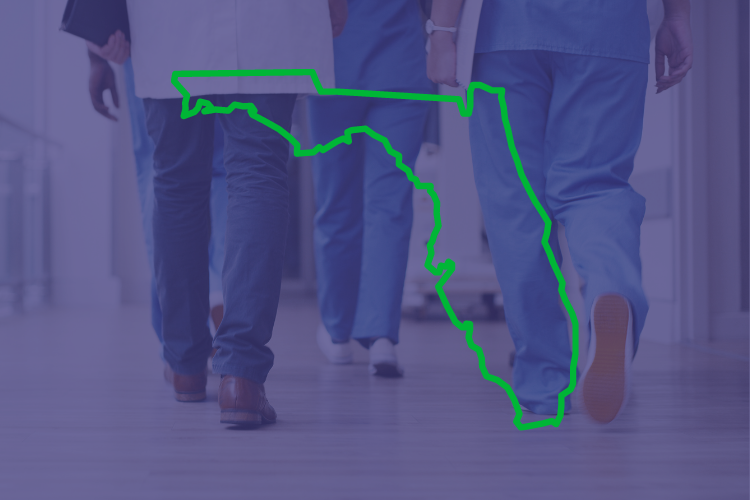Florida is one of the fastest growing states in the nation, but the number of practicing medical providers is not keeping pace. Being able to quickly complete medical credentialing services in Florida is lucrative for organizations and also important for the community.
My team and I complete the credentialing process for more than 300 Florida providers every year and I’d like to share some of what we’ve learned.
What’s Unique About Medical Credentialing in Florida
1. Florida Medicaid Portal
The Florida Medicaid Web Portal is very specific and if you aren’t familiar with submitting the documentation, it is easy to make a wrong turn. The application is done completely online and there are many pages to work through, a.nd the effective date of the enrollment depends on the application’s submission date.
2. Allot Time for Background Check
Background checks in Florida are a bit more complicated and lenghty for providers to complete than in other states. Providers must first submit their Medicaid enrollment application and receive the Application Tracking Number (ATN) before they can access the clearinghouse. There are then additional steps including fingerprints and obtaining a Florida Public Rap Sheet.
3. Durable Medical Equipment Suppliers
Enrolling as a durable medical equipment (DME or DMEPOS) supplier is a lengthy process in Florida. The state requires a process similar to Medicare, which includes obtaining DMEPOS accreditation from a CMS-approved organization, enrolling in Medicare, and posting a surety bond to the enrollment contractor.
Steps To Complete Provider Credentialing in Florida
Here are the general steps involved in completing medical credentialing in the state of Florida:
- Set Up Online Portals. Ensure the provider’s CAQH profile is up to date and set up a PECOS portal if the provider will be enrolling with Medicare. A The Florida Medicaid Web Portal account will also need to be created.
- Primary Source Verification. Primary source verification involves contacting original sources — such as educational institutions, licensing boards, and certification bodies — to confirm the authenticity and accuracy of the documents and qualifications provided by the provider. Payers in Florida have specific requirements.
- Work History and Reference Checks. To assess the provider’s experience and reputation within the healthcare community, their work history of the provider must be verified without any gaps longer than 30 days.
- Background Checks. Comprehensive background checks help rule out any criminal history, malpractice claims, disciplinary actions, or other records that might raisesend up red flags. This is a requirement for any Medicaid/Medicare network.
- Payer Enrollment. Providers must be enrolled with every payer they accept insurance from — again, before they start seeing patients. With an average of 5 – 10 payers per provider, this can be a time-consuming and tedious step that needs to start early in the credentialing process.
- Privileging. Privileging involves the collection and review of a provider’s documentation to determine if they’re eligible worthy to provide care to patients within a specific institution. All providers must receive privileges at the facility where they will see patients before they begin practicing.
Tips To Speed Up Credentialing in Florida
The time it takes to credential providers in Florida can vary depending on multiple a variety of factors. However, generally speaking, once the application is submitted it is usually about 30-60 days until the provider is enrolled. Recredentialing is much quicker — approximatelyit is about a a 10-day turnaround. The exact timeline depends heavily on the provider’s specialty, the volume of providers, and the efficiency and completeness of the provider’s documentation.
1. Start as soon as the provider is hired.
Knowing that medical credentialing in Florida can take longer than usual, make sure you start collecting documents as soon as possible. Early cCredentialing early will also alert you of anyofto any red flags or complications during the hiring and onboarding process.
2. Make it easy for providers to submit documents.
It is much easier for you and the provider to request digital documents as opposed to collecting a paper credentialing packet. Credentialing software offers the ability for providers to securely submit documents to an online portal.
3. Set a process specific to Florida’s payers.
Payers, such as Guidewell (Florida Blue), all have specific requirements for the state in which they are located. Understanding this process and creating checklists for each payer will help you to complete medical credentialing in Florida much more quickly. A process (workflow) ensures continuity in case the credentialing expert is out of the office or has moved on.
4. Set reminders and notifications.
Because credentialing in Florida could take a while, it is especially important to schedule reminders for follow-ups. There’s likely to be a lot of back-and-forth in verifying information, so be sure to schedule reminders every time there’s an additional step required to complete the action. Credentialing software can automate these reminders to ensure you don’t miss steps or deadlines.
View this guide for more tips on speeding up your credentialing process.
Keep Credentialing Organized for Florida Providers
A long process, with some parts online and some on paper, makes medical credentialing in Florida a challenge. Using medical credentialing services in Florida can help speed up the process because these credentialing specialists are used to the rules and regulations. In many cases, they have also developed good working relationships with the payers, which can smooth the process.
Find out how MedTrainer can help — whether you just need software or you’re looking for credentialing services to handle the process for you.
